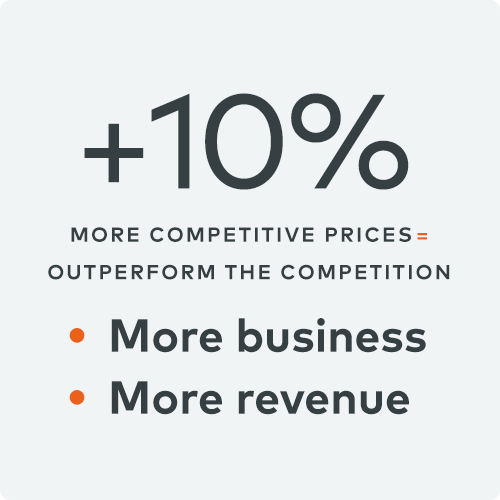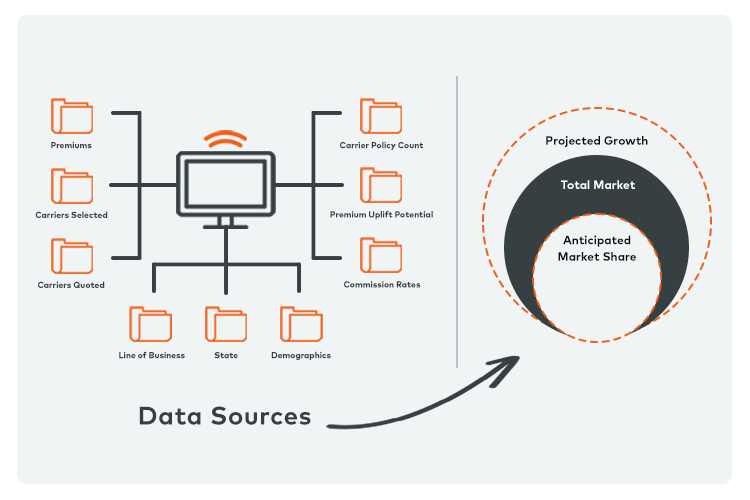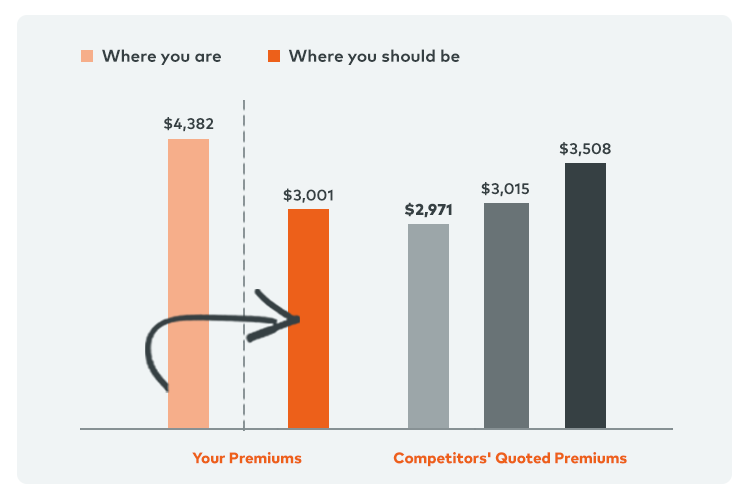Overview
Data and analytics best practices can help you uncover new opportunities hidden in your business data.
By now, it’s well understood that a robust and actionable data and analytics strategy is necessary for sustaining business growth in the digital era. But when every organization in a sector is working on developing or refining their own data strategy, finding the best strategy—one that maximizes the value of your unique business data—becomes especially critical.
Digital white paper contents

Without comprehensive data to provide insights into the market around you, it can be difficult to make decisions on how to best expand into new states or lines of business. In one study’s preliminary testing, "A carrier said they could price up to 10% more competitively in certain risk classes and lines of business by conducting data analyses."
These innovations are changing the carrier competitive landscape.PropertyCasualty360
Insurance carriers require data and analytics strategies that deliver clear, measurable value and growth. The three obstacles and considerations detailed herein can help you get the most out of yours.
Obstacles
Bad data is a costly problem, but knowing what to do with accurate data can be equally challenging.
Let’s look at a few common reasons organizations may struggle to fulfill their full data potential. In insurance and many other industries, three barriers tend to cause the most difficulty for organizations seeking to act on their data:
![]()
Data Quality
Incomplete, inconsistent, or duplicate data is a familiar issue every organization must face at some point. The task of cleaning up messy data requires a substantial investment of time, money, and personnel, especially when there is a backlog of offline files that must be digitized.
The process of analyzing and assembling unstructured information into valuable data isn’t easy or cheap. Compared with the immediate challenge posed by this undertaking, the future benefits of a data and analytics strategy may seem less certain.
![]()
Data Quantity
When it’s accurate, accessible, and readily actionable, you can never have too much data. But overly exhaustive efforts to correct the issue of missing data can generate more data than your team is prepared to handle, and complex data systems can quickly become disorganized. Data amassed from different sources often gets stuck in silos, too.
When your data becomes a dumping ground, it can make it difficult to isolate the precise information you need to answer a particular question and make an informed decision.
![]()
Data Doubts
Even when data is clean and insightful, the question of what someone is supposed to do with it often goes unanswered. Worse, data insights might be disregarded by key decision-makers who have not fully embraced the applicability of analytics to their consideration processes.
It’s not enough to produce pretty charts and tables and let the facts speak for themselves: a data and analytics strategy that doesn’t encompass routine workflows is an exercise in futility.
Considerations
Concentrating your strategy on operational realities will bring more tangible results and greater return on your investment.
It’s easy to get caught up in the complexities of data and its nuances, particularly for members of your data team. To overcome barriers and implement an effective data and analytics strategy, a competitive carrier should focus on three core aspects of their business.
Institutional Policies
Your data and analytics strategy will yield greater success in the long term if your data collection practices meet your current needs and can adapt to future requirements. To enable adaptability, your policies and workflows must reinforce complete, accurate data entry going forward, and your sales and customer service representatives must have the right tools to submit all necessary information.
An infrastructure that allows you to easily capture additional data as new needs arise is much simpler to implement than trying to add more functionality on the backend (or predict what information you might need). Of course, you will still need to retroactively clean up existing data, but these measures will prevent data quality from becoming a barrier again. Among some carriers, quarterly data cleanups are becoming mandatory at set times of the year, typically ahead of shareholder meetings.
Tip: Information that is important for your data and analytics strategy should always be collected through entry fields that are mandatory, not optional.
Practical Expectations
Taking a realistic assessment of your team’s data capabilities is a crucial step. An organization’s expectations of their data and analytics strategy should acknowledge how long it will take to digitize their historic records. In insurance, there is so much rich data available about the end-insured, in-force policies, risks, and more, but much of that information is stuck in paper documents.
Without an automated solution purpose-built for sourcing and extracting data, organizations should be realistic in how quickly they can expect data-driven results. Don’t overestimate what you can do with your data, and don’t underestimate the effort and time it takes to make real use of it.
Tip: To put your data and analytics strategy into practice, center it on real-world examples of the types of insights your strategy can realistically deliver. Being transparent about the practical business applications and benefits will help decision-makers understand why data and analytics deserve additional attention.
Internal Partnerships
Your data and analytics strategy should be a full-business initiative that aligns with and helps advance your organization’s overarching goals. This provides a common purpose to the cross-unit partnerships necessary for data collection, analysis, and operational change. Not every business unit will instinctively understand how certain data can help them, so it is important that they learn how it helps the organization.
For your data and analytics strategy to succeed, your information and technology leaders must partner with your business leaders to address their priorities and pain points. Their perspective helps the data team develop and contextualize insights, which helps all stakeholders better focus on new ways to make real changes that produce real results.
Tip: Some sales units think data is unhelpful because they interact with the customer directly. However, data and analytics can be very effective at identifying cross-sell opportunities by revealing buying patterns of similar customers, which enables sales representatives to recommend additional products. It can also predict which customers are more likely to churn, allowing customer service teams to take preventative action.
Possibilities
An effective data source for analytics empowers you to gain insights from win/loss ratios, improve pricing strategies, and expand to new markets.
To understand how carriers use aggregated market data to make strategic decisions, let’s consider a few scenarios where comparing your premium data with your competitors’ creates better business possibilities:
Example 1
For potential new markets
Visibility into large datasets for territories or risks you have not participated in previously allows you to target new areas for revenue. Having an accurate market perspective to plan pricing helps carriers compete and win new business. With data insights from an entire industry, you can analyze a variety of risks and capitalize on emerging markets faster.

Example 2
For targeted risks
You should rank among the top three carriers for an in-appetite line of business. Adjusting your premiums to be in the top three allows carriers the most opportunity to be the best fit for that risk. At the same time, carriers should seek to maximize revenue where the average premiums for preferred risks scenarios are higher overall.

Example 3
For risks that are less desirable
You should ensure that you do not rank in the top three, that you are not inadvertently competing for business that does not advance your overall market strategy. The competitiveness of your premiums should align with—not undermine—your tolerance for a particular risk.

Actions
The success of your data and analytics strategy depends on practical policies, adaptable infrastructure, and communicative relationships.
With accurate, accessible, and actionable information at your disposal, you can maximize the value of your business data. But to see—and seize—real opportunities in that data, focus on what’s right in front of you, first.
Quiz: Decision-Making With Data
Where do you rank on the road to dominating with data? This interactive questionnaire will help you find out.
Vertafore's Data-Driven Approach
Access data and insights to inform your approach to the market and optimize the quote/bind process for your partners.
Speak With a Data Expert
Wherever you are in your data journey, we're here to help. Explore the ways data can transform your business.
